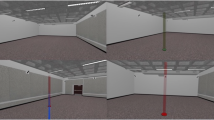Abstract
In this paper, we studied the relationship between the accuracy of the extrapolating data and the update interval in a distributed virtual environment (DVE). Based on the properties of the polynomial models, we proposed the new method to extrapolate the attribute data which arrives at a discrete time period. Theoretical models were formulated and showed that the average error of the proposed method is less than that of current methods. Finally, we confirmed that the proposed method can improve the accuracy in comparison with current methods by conducting experiments with the motion of a pen for a series of letters written by a human.
Similar content being viewed by others
Explore related subjects
Discover the latest articles, news and stories from top researchers in related subjects.References
Berglund, E.J., Cheriton, D.R.: Amaze: a multiplayer computer game. IEEE Software 2(3), 30–39 (1985)
Capin, T.K., Esmerado, J., Thalmann, D.: A dead-reckoning technique for streaming virtual human animation. IEEE Trans. Circ. Syst. Video Technol. 9(3), 411–414 (1999)
Delaney, D., Ward, T., McLoone, S.: On consistency and network latency in distributed interactive applications: a survey – part II. Presence Teleoper. Virt. Environ. 15(4), 465–482 (2006)
Ellis, S.R., Wolfram, A., Adelstein, B.D.: Three dimensional tracking in augmented environments: user performance trade-offs between system latency and update rate. In: Proceedings of the Human Factor and Ergonomics Society, pp. 2149–2154, Baltimore, MD (2002)
Fritsch, T., Ritter, H., Schiller, J.: The effect of latency and network limitations on MMORPGs (a field study of everquest2). In: Proceedings of 4th ACM SIGCOMM Workshop on Network System Support for Games NetGames ’05, Hawthorne, New York (2005). DOI http://doi.acm.org/10.1145/1103599.1103623
Fujinoki, H.: On the support for heterogeneity in networked virtual environment. In: ACM SIGCHI Proceedings of Netgames 2006 & 5th Workshop on Network & System Support for Games 2006 (CD-ROM), Singapore (2006)
Gutwin, C., Dyck, J., Burkitt, J.: Using cursor prediction to smooth telepointer jitter. In: Proceedings of the 2003 International ACM SIGGRAPH Conference on Supporting Group Work, pp. 294–301, Sanibel Island, FL (2003)
Hagsand, O.: Interactive multiuser VEs in the DIVE system. IEEE MultiMedia 3(1), 30–39 (1996)
Hanawa, D., Yonekura, T.: On relationship between network latency and information quality in a synchronized distributed virtual environment. In: IEEE Proceedings of Virtual Reality 2004, pp. 227–228, Chicago, IL (2004)
Hanawa, D., Yonekura, T.: An error analysis of polynomial form dead reckoning model based on a numerical analysis. Electron. Int. J. Adv. Model. Optimiz. 7(1), 85–98 (2005)
Hanawa, D., Yonekura, T.: On the error modeling of the dead reckoned data in a distributed virtual environment. In: Proceedings of International Conference on Cyber Worlds 2005, pp. 279–286, Singapore (2005)
Hanawa, D., Yonekura, T.: A proposal of dead reckoning protocol in distributed virtual environment based on the Taylor expansion. In: Proceedings of International Conference on Cyber Worlds 2006, pp. 107–114, Lausanne, Switzerland (2006)
Hikichi, K., Arimoto, I., Morino, H., Sezaki, K., Yasuda, Y.: The evaluation of adaptation control for haptics collaboration over the Internet. In: IEEE Proceedings of 16th International Workshop on Communications Quality & Reliability CQR2002, CQR–033, pp. 218–222, Okinawa, Japan (2002)
Institute of Electrical and Electronics Engineers, International Standard, ANSI/IEEE Std 1278-1993: Standard for information technology, protocols for distributed interactive simulation. IEEE, Washington, DC (1993)
Kamada, M., Enkhbat, R., Kawahito, T.: Synthesis of letter strings in script style based on minimum principle. Electron. Int. J. Adv. Model. Optimiz. 6(1), 37–56 (2004)
Macedonia, M.R., Zyda, M.J., Pratt, D.R., Barham, P.T., Zewsitz, S.: NPSnet: a network software architecture for large scale virtual environment. Presence Teleoper. Virt. Environ. 3(4), 265–287 (1994)
Marshall, D., McLoone, S., Roberts, D., Delaney, D., Ward, T.: Exploring the effect of curvature on the consistency of dead reckoned paths for different error threshold metrics. In: IEEE Proceedings of the 2006 10th International Symposium on Distributed Simulation and Real-Time Applications, pp. 77–84, Torremolinos, Malaga, Spain (2006)
Neumaier, A.: Introduction to Numerical Analysis. Cambridge University Press, Cambridge (2001)
Ohlenburg, J.: Improving collision detection in distributed virtual environments by adaptive collision prediction tracking. In: IEEE Proceedings of Virtual Reality 2004, pp. 83–90, Chicago, IL (2004)
Pozrikidis, C.: Numerical Computation in Science and Engineering. Oxford University Press, New York (1998)
Roberts, D., Marshall, D., McLoone, S., Delaney, D., Ward, T., Aspin, R.: Exploring the use of local consistency measures as thresholds for dead reckoning update packet generation. In: IEEE Proceedings of the 2005 9th International Symposium on Distributed Simulation and Real-Time Applications, pp. 195–202, Montreal, Quebec, Canada (2005)
Singhal, S.K.: Effective remote modeling in large-scale distributed simulation and visualization environments. Dissertation, Stanford University, Department of Computer Science URL http://www.dsg.standford.edu/singhal/thesis.ps (2006)
Singhal, S.K., Cheriton, D.R.: Exploring position history for efficient remote rendering in networked virtual reality. Presence Teleoper. Virt. Environ. 4(2), 169–193 (1995)
Singhal, S.K., Zyda, M.J.: Networked Virtual Environments: Design and Implementation. Addison-Wesley, Boston (1999)
Yasui, T., Ishibashi, Y., Ikedo, T.: Influence of network latency and packet loss on consistency in networked racing games. In: Proceedings of 4th ACM SIGCOMM Workshop on Network System Support for Games NetGames ’05. Hawthorne, NY (2005). DOI http://doi.acm.org/10.1145/1103599.1103622
Yonekura, T., Hanawa, D.: A study of prediction by the Taylor Expansion of distributed virtual environment’s data with network latency. The Institute of Electronics, Information and Communication Engineers Transactions on Information and Systems, Part II J87-D-II(12), 2209–2220 (2004). In Japanese
Zhou, S., Cai, W., Lee, B.S., Turner, S.J.: Time-space consistency in large-scale distributed virtual environments. ACM Trans. Model. Comput. Simul. 14(1), 31–47 (2004)
Author information
Authors and Affiliations
Corresponding author
Rights and permissions
About this article
Cite this article
Hanawa, D., Yonekura, T. Improvement on the accuracy of the polynomial form extrapolation model in distributed virtual environment. Visual Comput 23, 369–379 (2007). https://doi.org/10.1007/s00371-007-0109-8
Published:
Issue Date:
DOI: https://doi.org/10.1007/s00371-007-0109-8




